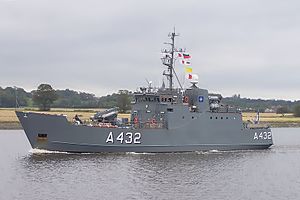Lindormen-class minelayer
 ENS Tasuja passing Clydebank on her way to KGV Dock in Glasgow, JW112 participant
| |
| Class overview | |
|---|---|
| Name | Lindormen class |
| Builders | Svendborg Skibsværft |
| Operators | |
| Built | 1977 |
| In commission | 1978 - present |
| Planned | 2 |
| Completed | 2 |
| Active | 1 |
| Laid up | 2 |
| Retired | 1 |
| General characteristics | |
| Type | Minelayer |
| Displacement | 577 tons full |
| Length | 44.5 m (146 ft 0 in) |
| Beam | 9.0 m (29 ft 6 in) |
| Height | 21 m (68 ft 11 in) |
| Draught | 2.9 m (9 ft 6 in) |
| Propulsion |
|
| Speed | 14 knots (26 km/h; 16 mph) |
| Complement | 27 (4 officers and 23 ratings) |
| Armament | 2 x 20 mm Machine Gun Mk M/42 LvSa (1 fore & 1 aft) |
The Lindormen class is a class of minelayers built for the Danish Navy. The Lindormen class is currently in service with the Estonian Navy.
History
The class consists of two ships: KDM Lindormen (N43) (transl. Dragon) and KDM Lossen (N44) (transl. Lynx). The purchase of the cable-minelayers was approved in the 1973 defence bill. The ships were built by Svendborg Skibsværft in 1977 and commissioned on 14 June 1978. One of the ships served as a command and support ship in STANAVFORCHAN, under Danish Navy. Both ships were decommissioned by the Danish Navy on 22 October 2004 and sold to Estonia in 2006. They were renamed EML Tasuja (A432) and EML Wambola (A433) and would later find service in the Standing NATO Mine Countermeasures Group 1. Wambola was held in reserve until it replaced Tasuja in Estonian Navy service in 2016.[1][2]
Design
The ships have a steel hull and were originally designed to lay controlled minefields, though they would later be used as support vessels. The ships were initially propelled by two 800 horsepower Frichs diesel engines with two adjustable propellers. They were later replaced with two MTU diesel engines, providing 1600 kW of power in total. The ships were initially armed with two Oerlikon 20 mm cannons - one fore and one aft. In 1985, another 20 mm cannon was added to the fore. In 1997, a pair of FIM-92 Stinger launchers were also added. The weapons were removed when they were sold to Estonia. Estonian Navy later equipped the ships with M2 Browning machine guns. They are also equipped with two I-band navigation radars, two cranes (one 2 tonne crane fore and one 2.8 tonne crane aft) and two boats. The ships have a large mine deck, sufficient for carrying 50-60 naval mines, but can also be used for diving support, training or command duties.[1][3]
References
- ^ a b Olsen, Gunnar; Storgaard, Svenn (1998). Flådens skibe og fartøjer 1945-1995 (in Danish). Marinehistorisk selskab. ISBN 87-87720-13-2.
- ^ "Krudttårnet" (PDF) (in Danish). 9 (Nr. 4). November 2004: 13. Retrieved 2018-01-24.
{{cite journal}}:|issue=has extra text (help); Cite journal requires|journal=(help) - ^ "Lindormen klass". mil.ee (in Estonian). Retrieved 2018-01-23.
